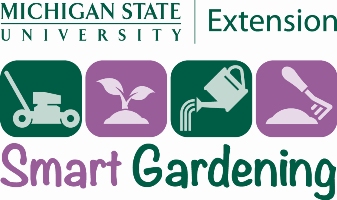This past March, I was able to attend a Smart Gardening conference through the MSU Extensions office. Dr. Rufus Isaacs, small fruit entomologist and professor at MSU, gave a presentation about bees as important pollinators in orchards and gardens. He shared with us some ideas on why the little guys are so helpful and how we can make them feel more welcome in our gardens.
1. Feed Them
Bees pollinate 80% of plant species that provide us and other wildlife with food. Growing plants in the garden to feed the bees introduces biodiversity into the garden, improves crop productions, slows the bee population decline, and provides wildlife to observe and enjoy.
When selecting garden plants for bees, try first browsing through native plants. Also, Dr. Isaacs suggested to pick a variety of plants that bloom throughout the growing season so the bees always have a food source available. For Michigan, there are native plants resources provided free of cost at www.nativeplants.msu.edu. I used the site to look up some natives to fit in the Lot’s USDA Hardiness Zone 6a. Here are some I’m going to try:
- Golden Alexanders (Zizia aurea) – blooms mid May-June
- Culver’s Root (Veronicastrum virginicum) – blooms July-Sept
- Great Blue Lobelia (Lobelia siphilitica) – blooms end of July into Oct
- Smooth Aster (Symphyotrichum laeve (Aster laevis)) – blooms Sept-Oct
2. House Them
One thing I didn’t realize before the conference is bees are both hive and solitary creatures. I am most familiar with the Honey Bee brought over from Europe in the 1600s to provide wax and honey. Pooh Bear had taught me these bees live together in hives and produce delicious golden honey. But many types of bees are actually hard-working, single mothers. After mating, they build individual nests often located in the ground. The nest cells are stocked with pollen and are sealed to protect the bee larvae when it hatches. Here are a few ways to offer housing for the garden’s bees:
- Within the garden, leave an area of bare ground available for nesting. An ideal place would be one that is out of the way of high foot traffic and can remain undisturbed.
- Create a nesting tube or bee house. There are many instructional videos online for this. Just remember to not use treated lumber for construction.
- Build a bee spiral (or herb spiral) into the landscape design. This gradually elevated bed provides soil and cracks between bricks or stones that are ideal for nesting. Bonus, it’s a type of modified garden bed, so you can use it grow plants pollinators enjoy.
- Grow plants bees can use as nesting material.
3. Don’t Kill Them
Seems like a pretty obvious tip, right? However, some homeowners are afraid of bees and try to spray for them. Other gardeners go crazy with insecticides because a prized plant is being eaten by a pest. Always be cautious when spraying chemicals in the garden. Just because the insecticide is advertised to kill one type of harmful insect does not prevent it from also killing pollinators like bees and natural predators like other beneficial insects and birds. We try to avoid the use of insecticides, or any other type of pesticide, on the Lot.
Bees are not naturally aggressive and only sting when their nests are endangered or someone is actively trying to swat them from the sky. If a ground nest takes form near something like a swingset, a very simple solution is to move the swingset. If that is not possible, try making a much more attractive (and less traveled) area of the garden available for the bees.
Additional Info
More info on bees and other pollinators can be found at:
Pollinator Partnership
MSU Native Plants and Ecosystem Resources
